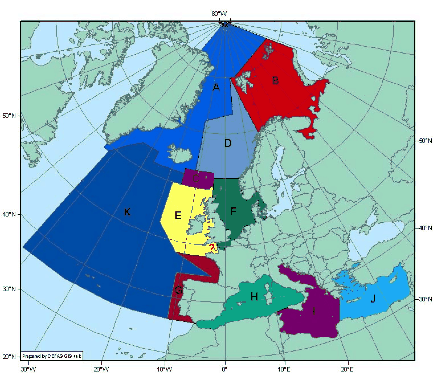Case Studies
Celtic Sea Ecoregion

Fig. 1. The Celtic Sea Ecoregion, E, yellow box. (From Report of the ICES Advisory Committee on Fishery Management and Advisory Committee on the Ecosystem, 2004)
The Celtic Sea ecoregion is composed of the ICES rectangles VI and VII rather than by any natural features and is one of 11 ecoregions in European waters. An ecoregion is chosen as an individual regional area for which ecological objectives can be defined. The boundaries should be defined in terms of the biogeographical and oceanographic characteristics of the area but should also take into account the political, social, economic and management divisions. As a result there is still uncertainty as to whether the western part of the English Channel should be included in the Celtic Sea or North Sea ecoregions. The biogeographical characteristics typically used in boundary definition are faunal communities and patterns of primary production and oceanographic characteristics include bathymetry, tidal and ocean circulation and stratification.
The area contains notable bathymetric features such as the Porcupine Plateau, Seabight and Abyssal Plain, the Rockall Trough and Plateau, the Goban Spur and the Anton Dorn seamount as well as various other smaller seamounts. These seamounts are especially important for fish stocks, due to their elevation compared to lower areas of the region and also due to the high biodiversity created by the cold-water coral reef habitat, with populations of long-lived orange roughy congregating around the mounts. The continental slope has many steep canyons and ridges that have a significant role in the various life stages of many pelagic fish species.
The Gulf Stream passes through the Celtic Sea Ecoregion bringing warm water and nutrients with it that support the wide variety of species in the area. The Gulf Stream is also an important migratory route for many species such as the leatherback turtles and the European Eel. Another noticeable feature of the Gulf Stream are the eddies which form along its border. These eddies help to mix colder water with warmer water, aid the transfer of nutrients and move large volumes of larval species around the North East Atlantic.
The ecoregion is not only important for commercial species such as hake, cod, haddock, plaice, nephrops, mackerel, horse mackerel, herring, anglerfish, and megrim, in terms of spawning and nursery grounds, but there is also a significant presence of porpoises, dolphins, whales, sharks, rays, oceanic birds and leatherback turtles. Many of these species, such as the leatherback turtle, migrate towards the Celtic Sea area during the summer and with recent evidence that they may be moving further north as water temperatures increase. The Irish Exclusive Economic Zone is within the Celtic Sea Ecoregion and has been designated a whale and dolphin sanctuary. Cold-water coral reefs, Lophelia pertusa, can be found around Rockall, the Porcupine Seabight, on seamounts and along most of the continental slope. They are usually 'hotspots' for marine life with many types of worms, crustaceans and sponges gathering around them which in turn attract a wide range of commercially important fish species. The ecoregion is larger version of the ecoregion that was agreed upon in the 1990's, mainly due to the increased knowledge about cold-water coral reefs that can be found along the continental slope down to depths of 1000m and are susceptible to damage by fishing gear.
This ecoregion supports a significant capture fishery industry with 1.9 million tonnes been landed from ICES areas VI and VII in 2007. In terms of TAC's Ireland received 20% of pelagic species quotas, 13% of demersal species quotas and 23% of the shellfish quota.
For more information see:
Report of the ICES Advisory Committee on Fishery Management and Advisory Committee on Ecosystem, 2004Annual Report on the Irish Fishing Fleet for 2008, DAFF
Cold-Water Coral Reefs
European Atlas of the Seas (be sure to click on fishing opportunities to analyse national fleet species-quotas.)
COSTELLO, M.J., MCCREA, M., FREIWALD, A., LUNDALV, T., JONSSON, L., BETT, B.J., VAN WEERING, T.C.E., DE HAS, H., ROBERTS, J.M., ALLEN, D., 2005. Role of cold-water Lophelia pertusa coral reefs as fish habitat in the NE Atlantic. Cold-Water Corals and Ecosystems, pp. 771-805.
FOSSETTE, S., GIRARD, C., LOPEZ-MENDILAHARSU, M., MILLER, P., DOMINGO, A., EVANS, D., KELLE, L., PLOT, V., PROSDOCIMI, L., VERHAGE, S., GASPAR, P., GEORGES, J-Y., 2010. Atlantic leatherback migratory paths and temporary residence areas. Plos One, 5, pp. e13908.
LETERME, S.C., PINGREE, R.D., 2008. The Gulf Stream, rings and North Atlantic eddy structures form remote sensing (Altimeter and SeaWiFS). Journal of Marine Systems, 69, pp. 177-190.
Study Areas